Exam Details
Exam Code
:5V0-41.20Exam Name
:VMware SD-WAN TroubleshootCertification
:VMware CertificationsVendor
:VMwareTotal Questions
:36 Q&AsLast Updated
:Mar 23, 2025
VMware VMware Certifications 5V0-41.20 Questions & Answers
-
Question 11:
Scenario 2:
After resolving numerous connectivity Issues throughout the various branch sites, connectivity between applications and users is finally present. The network administrator is informed that during certain tests, applications are not performing as they are expected to. Users report that call quality has not fully improved and that some of their calls either drop or have poor voice quality where the conversation is breaking up. Other users are noticing that file transfers are slower than expect. A group of users from a few sites have reported slowness in accessing internal and external applications.
Exhibit.
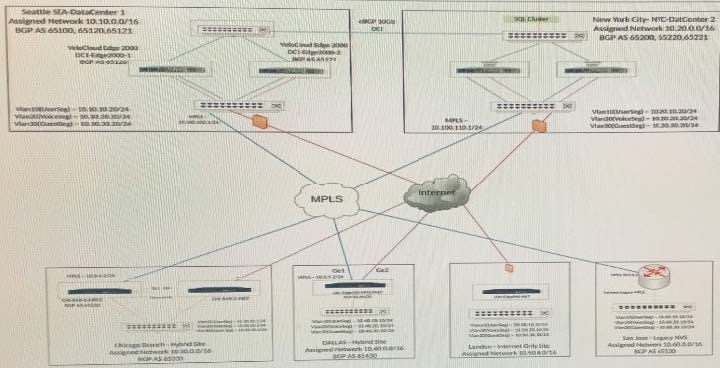
A network administrator has configured a Business Policy to send a specific application directly out an underlay interface. Users have complained of slow responses for that application. While troubleshooting, the network administrator finds the traffic is actually taking an overlay path to another SD-WAN Edge.
What is causing this behavior?
A. The other Edge location is advertising a secure route for the application's subnet.
B. uI has been configured forcing traffic into the underlay towards the hub.
C. Configuring Business Policy Direct settings have no affect on traffic flows.
D. Internet Backha.
E. The underlay path is not available forcing traffic into the overlay.
-
Question 12:
Scenario 3:
After resolving numerous connectivity Issues throughout the various branch sites, connectivity between applications and users is finally present- The network administrator is informed (hat during certain tests, applications are not performing as they are expected to. Users report that call quality has not fully improved and that some of their calls either drop or have poor voice quality where the conversation is breaking up. Other users are noticing that file transfers are slower than expect. A group of users from a few sites have reported slowness in accessing internal and external applications.
Exhibit.
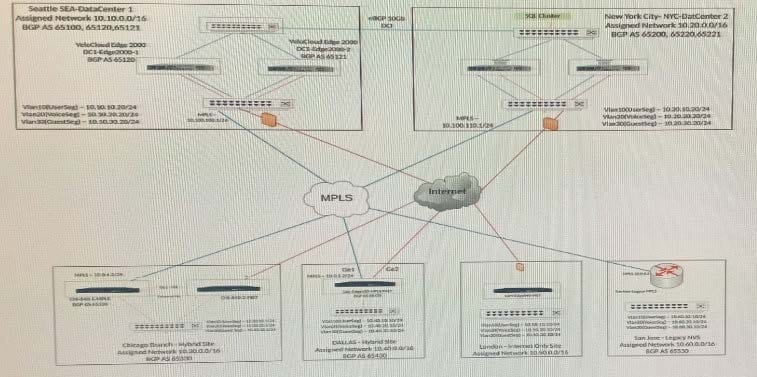
Which metrics can a network administrator verify in the QoE screen to determine the overall health of Underlay and Overlay?
A. Jitter Packet Loss, Speed.
B. Jitter, Packet Loss, Latency.
C. Jitter, Speed, Latency.
D. Packet Loss, Latency, Speed.
-
Question 13:
Scenario 3:
After resolving numerous connectivity Issues throughout the various branch sites, connectivity between applications and users is finally present. The network administrator is informed that during certain tests, applications are not performing as they are expected to. Users report that call quality has not fully improved and that some of their calls either drop or have poor voice quality where the conversation is breaking up. Other users are noticing that file transfers are slower than expect. A group of users from a few sites have reported slowness in accessing internal and external applications.
Exhibit.
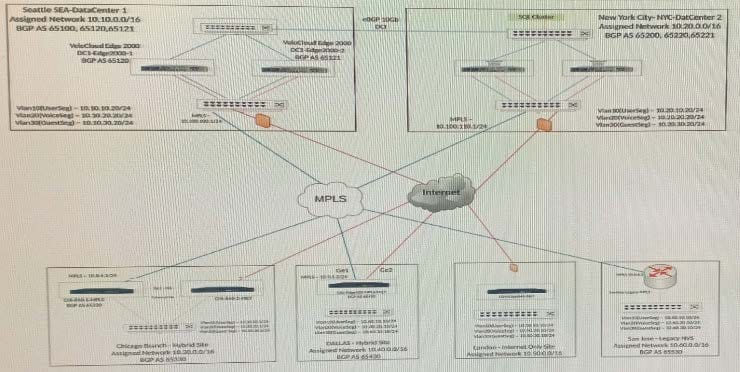
The network administrator has been made aware that Chicago is receiving traffic from non- SD-WAN sites, bottlenecking Chicago's interfaces. The network administrator's VMware SE has mentioned using the uplink feature to help resolve this.
What are two ways the uplink feature should be used in this scenario? (Choose two.)
A. Set the uplink community to forward traffic to a group of neighbors.
B. Direct all traffic to that neighbor designated as an uplink,
C. Stop mutual redistribution of routes from underlay and overlay.
D. Prevent the site in question from becoming a transit site.
-
Question 14:
Scenario 2:
After completing the branch activation activities for all required branches, the network administrator attempts to test connectivity between the various branches and between the hubs and branches. The administrator notices a lack of connectivity despite being certain that configurations have been complete. The administrator also observed that several users are reporting intermittent connectivity to some of the applications they are accessing. Other users are reporting no access to these applications. Other users at some of the branches claim they cannot get to certain public resources. The administrator wants to ensure that all sites can talk to each other and all resources are accessible.
Exhibit.
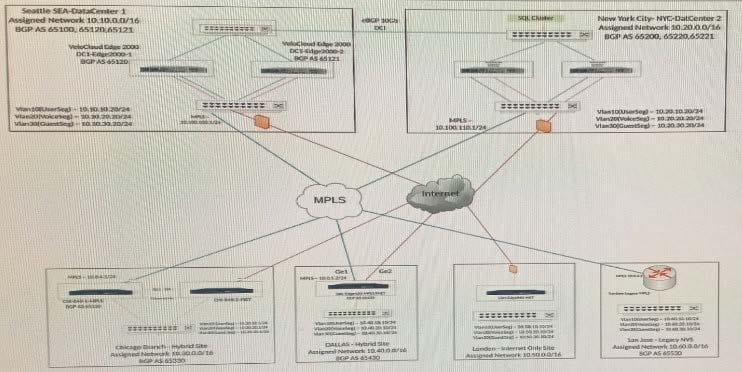
Several reports have come in from branch locations indicating customers cannot reach applications being served by the hub location. The hub location has a single LAN-side port from which it should be learning dynamic routes for the subnets serving the applications.
How should the technician verify if the ports on the Edge are up and working?
A. Look under Administration and System Settings to verify if the interfaces are configured and enabled.
B. Look in Test and Troubleshoot under the Remote Diagnostics and run Interface status.
C. Look in Test and Troubleshoot under the Remote Actions and run System Health.
D. Look in Test and Troubleshoot under the Remote Diagnostics and run System Health.
-
Question 15:
Scenario 3:
After completing the branch activation activities for all required branches, the network administrator attempts to test connectivity between the various branches and between the hubs and branches. The administrator notices a lack of connectivity despite being certain that configurations have been complete. The administrator also observed that several users are reporting intermittent connectivity to some of the applications they are accessing. Other users are reporting no access to these applications. Other users at some of the branches claim they cannot get to certain public resources. The administrator wants to ensure that all sites can talk to each other and all resources are accessible.
Exhibit.
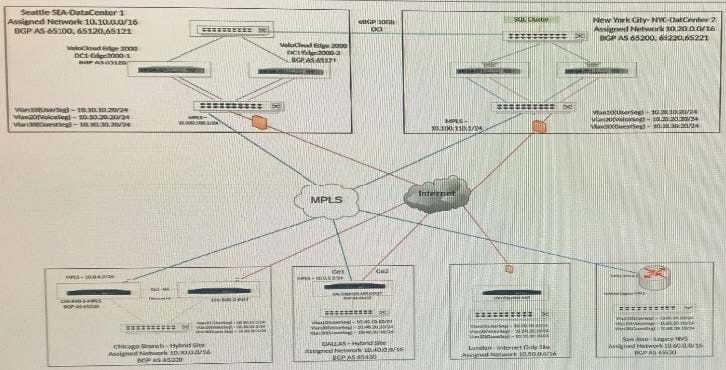
The network administrator determines that dynamic routes to SD-WAN sites are missing at the San Jose branch router. The network administrator decides to look into the configurations of hub Edges. All SD-WAN branch sites must use a hub to communicate with the San Jose site. Best practices have been implemented at these SD-WAN sites.
Where should the administrator check first to verify if the configuration is correct?
A. Verify that the NVS feature is enabled in Cloud VPN.
B. Verify that redistribution between the primary hub site and San Jose is enabled.
C. Verify the static routes to San Jose from all Branches are configured.
D. Verify that redistribution at the Dallas Hybrid Site is enabled for San Jose to use as a peering point.
-
Question 16:
Scenario 2:
After completing the branch activation activities for all required branches, the network administrator attempts to test connectivity between the various branches and between the hubs and branches. The administrator notices a lack of connectivity despite being certain that configurations have been complete. The administrator also observed that several users are reporting intermittent connectivity to some of the applications they are accessing. Other users are reporting no access to these applications. Other users at some of the branches claim they cannot get to certain public resources. The administrator wants to ensure that all sites can talk to each other and all resources are accessible.
Exhibit.
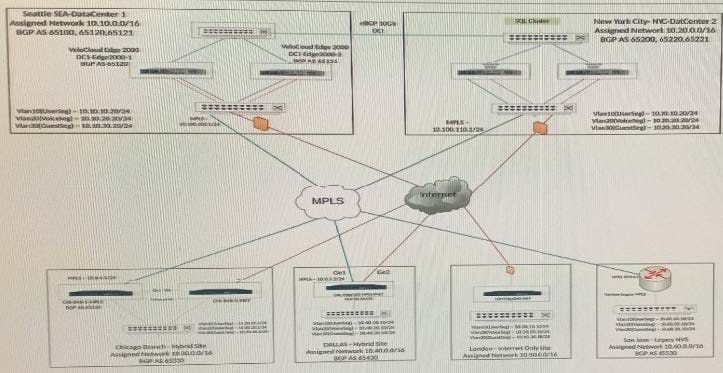
The SD-WAN Edge at this location has been activated. It is incapable of establishing any overlay tunnels. Due to this being an internet only branch, no underlay connectivity is present to the hubs. The SD-WAN Edge is connected behind a firewall and the security team states that all necessary ports are open.
How can this issue be resolved?
A. The security team needs to open TCP port 4500 instead of TCP port 2426.
B. The security team need to open TCP port 2426 outbound but not inbound.
C. The security team needs to open TCP port 22 instead of TCP port 2426.
D. The security team needs to open UDP port 2426 outbound and inbound.
-
Question 17:
Scenario 2:
After completing the branch activation activities for all required branches, the network administrator attempts to test connectivity between the various branches and between the hubs and branches. The administrator notices a lack of connectivity despite being certain that configurations have been complete. The administrator also observed that several users are reporting intermittent connectivity to some of the applications they are accessing. Other users are reporting no access to these applications. Other users at some of the branches claim they cannot get to certain public resources. The administrator wants to ensure that all sites can talk to each other and all resources are accessible.
Exhibit.
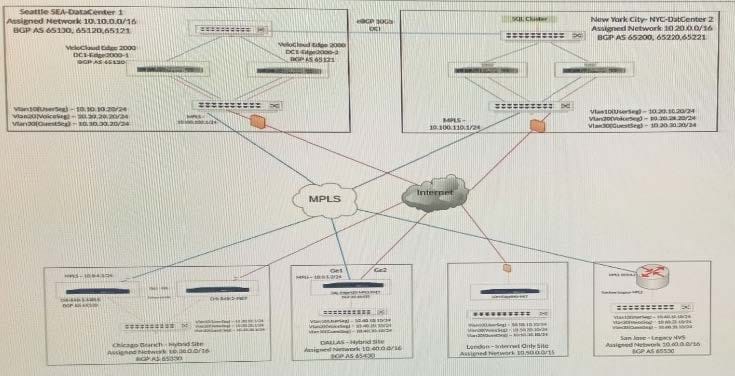
A network administrator is investigating connectivity issues between Chicago and San Jose. The administrator browses to the Overlay Flow Control (OFC) window and notices that the screen is blank with no routes shown in the OFC.
What is a possible reason for this?
A. Cloud VPN for the Edges / Profiles is not enabled.
B. There is an invalid MTU configuration at Chicago.
C. OSPF or BGP is not enabled.
D. The routing table on the Edges has not been initialized.
-
Question 18:
Scenario 2:
After completing the branch activation activities for all required branches, the network administrator attempts to test connectivity between the various branches and between the hubs and branches. The administrator notices a lack of connectivity despite being certain that configurations have been complete. The administrator also observed that several users are reporting intermittent connectivity to some of the applications they are accessing. Other users are reporting no access to these applications. Other users at some of the branches claim they cannot get to certain public resources. The administrator wants to ensure that all sites can talk to each other and all resources are accessible.
Exhibit.
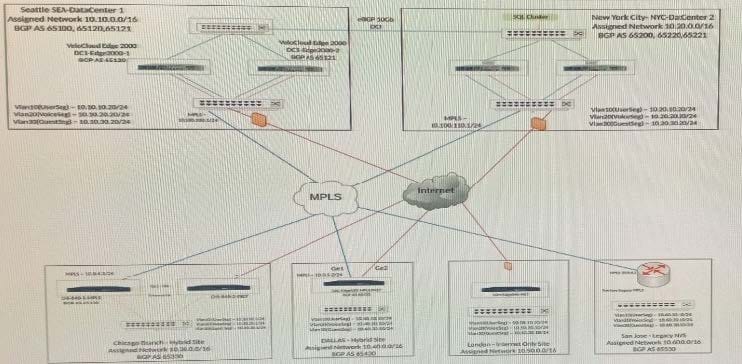
The tunnel from spoke to hub is not coming up. What are the two possible reasons? (Choose two.)
A. Spoke Edge and hub Edge are two different Edge models.
B. Spoke Edge and hub Edge have a mismatch certificate authentication mode.
C. Hub WAN Interface might be behind the NAT Device or firewall.
D. Dynamic Branch to Branch is not enabled.
-
Question 19:
Scenario 3:
After resolving numerous connectivity issues throughout the various branch sites, connectivity between applications and users is finally present. The network administrator is informed that during certain tests, applications are not performing as they are expected to. Users report that call quality has not fully improved and that some of their calls either drop or have poor voice quality where the conversation is breaking up. Other users are noticing that file transfers are slower than expect. A group of users from a few sites have reported slowness in accessing internal and external applications.
Exhibit.
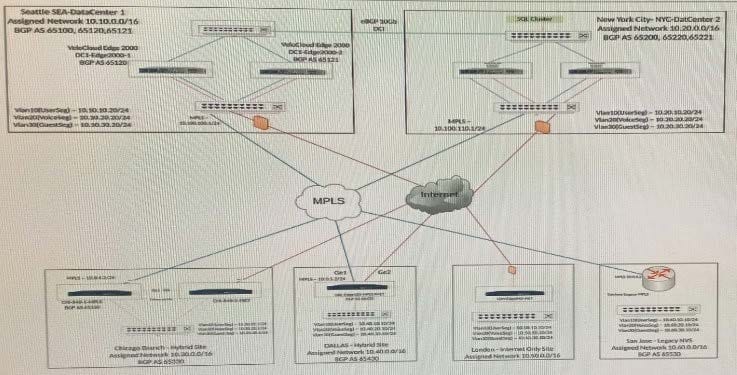
A network administrator decides to deploy a local Checkpoint VNF appliance on the Edge in London to cut back on unnecessary traffic towards the NY hub location.
The Checkpoint VNF and associated security services were successfully deployed at the London Branch. Users are now are complaining that Webpages are extremely slow to load, just like before.
What should the administrator do?
A. Reboot the Edge, as this is a requirement in the deployment of a Security VNF.
B. Disable and redeploy the VNF with lower memory requirements.
C. Verify to see if a firewall rule in the Edge is set to allow traffic to the Checkpoint VNF.
D. Check the flow records in Remote Diagnostics.
-
Question 20:
Scenario 2:
After completing the branch activation for all required branches, the network administrator attempts to test connectivity between the various branches and between hubs and branches. The administrator notices a lack of connectivity despite being certain that configurations have been complete. The administrator also observed that several users are reporting intermittent connectivity to some of the some applications they are accessing. Other users are reporting no access to these applications. Other users at some of the branches claim they cannot get to certain public resources. The administrator wants to ensure that all sites can talk to each other and all resources are accessible.
Exhibit.
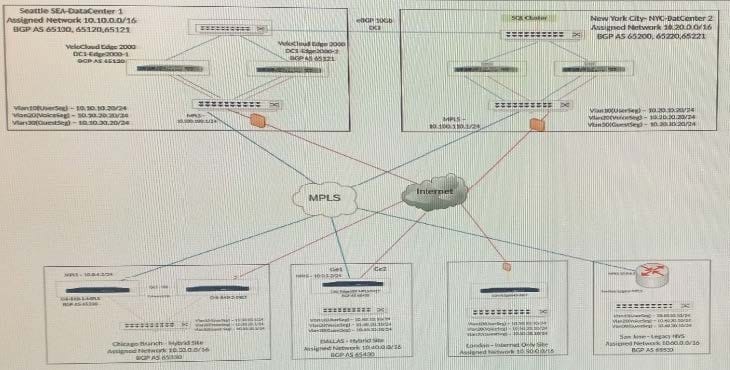
A technician has added Edges to an East Coast Profile. These Edges are not able to communicate via dynamic tunnels to Edges in the West_Coast profile. The technician has noticed that some Edges are able to establish dynamic tunnels.
What could be preventing Edges from being able to establish dynamic tunnels?
A. The profiles are not configured to allow dynamic branch to branch VPNs.
B. The profiles are configured to only allow dynamic branch to branch for Edges within the same profile.
C. None of the existing profiles have Cloud VPN enabled thus preventing dynamic tunnels.
D. Neither profile has been configured to utilize cloud gateways.
Related Exams:
1V0-21.20
Associate VMware Data Center Virtualization1V0-31.21
Associate VMware Cloud Management and Automation1V0-41.20
Associate VMware Network Virtualization1V0-61.21
Associate VMware Digital Workspace1V0-71.21
Associate VMware Application Modernization1V0-81.20
Associate VMware Security2V0-21.20
Professional VMware vSphere 7.x2V0-21.23
VMware vSphere 8.x Professional2V0-31.21
Professional VMware vRealize Automation 8.32V0-31.23
VMware Aria Automation 8.10 Professional
Tips on How to Prepare for the Exams
Nowadays, the certification exams become more and more important and required by more and more enterprises when applying for a job. But how to prepare for the exam effectively? How to prepare for the exam in a short time with less efforts? How to get a ideal result and how to find the most reliable resources? Here on Vcedump.com, you will find all the answers. Vcedump.com provide not only VMware exam questions, answers and explanations but also complete assistance on your exam preparation and certification application. If you are confused on your 5V0-41.20 exam preparations and VMware certification application, do not hesitate to visit our Vcedump.com to find your solutions here.